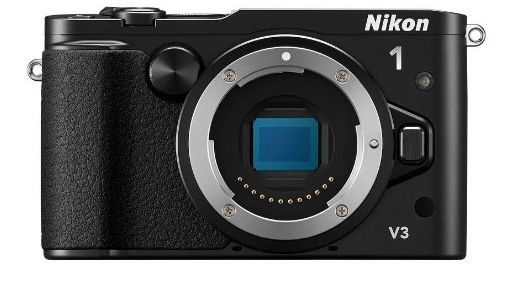Nikon 1 V3 Release Date - Review
Nikon 1 V3 Release Date - Nikon's third-generation Series 1 camera is right here. The new Nikon 1 V3 flagship mirrorless electronic camera is slimmed-down, lightened-up, as well as built for speed. It has a new 18.4-megapixel CX-format CMOS sensor with 105 ingrained stage detect AF points. The new EXPEED 4A processor allows the V3 to record full-resolution RAW images at approximately 20 frameworks per 2nd with continuous car emphasis-- that's faster than even one of the most powerful, most costly specialist DSLRs. The boosted EXPEED 4A handling permits the V3 to tape full-HD 60p video as well as 720p at 120 FPS. The V3 is additionally the first Nikon 1 cam to get built-in Wi-Fi, making it very easy to share pictures and videos from nearly anywhere.
 |
| Nikon 1 V3 Release Date - Review |
Compare pictures of the brand-new Nikon 1 V3 to the previous Nikon 1 front runner cams, and it's clear they've taken a new layout tack. The V3 looks a lot even more like the J-Series cams and even Nikon's P7800 costs Coolpix small. It's smaller compared to the V1 or V2 as well as fairly certainly missing out on the integrated digital viewfinder (EVF) that utilized to protrude upwards from the top deck. Don't worry, though-- Nikon has a new device EVF (DF-N1000) that looks to be even better. Not just does it aid maintain the video camera smaller sized, given that you don't need to utilize it if you don't intend to. But it's also a much better EVF, with a 2.35-million-dot resolution, diopter modification, and also a vehicle eye sensor so it toggles itself on and off. If you aren't utilizing the EVF, there's a new 3-inch, tilting touchscreen LCD present with touch shutter and also touch emphasis. The controls have actually also been enhanced with double exposure modification dials and also 2 adjustable function buttons. For people who such as a larger camera, Nikon is supplying an accessory grasp (GR-N1010) that adds a 3rd function switch and also another exposure control dial.
There is one disadvantage to the brand-new body style. In order to help maintain it little, Nikon switched the SD flash memory card port for a Micro SD card slot. Micro SD cards might be small yet they have large child performance, now. However, they're so little that I'm really anxious regarding shedding or damaging them. I would certainly have liked to see Nikon stick to typical SD cards for the V3-- particularly taking into consideration the high level of performance the cam has. Micro SD cards simply don't seem professional.
Performance-wise, Nikon's 1 Collection mirrorless electronic cameras have actually constantly led the curve, with incredible continual auto focus performance, super-fast still photo burst prices, and great video. I was really surprised when I reviewed the initial generation Nikon 1 J1 (check out the Nikon 1 J1 testimonial). It was the first interchangeable lens camera I would certainly made use of that had able to be used motion picture setting continual car emphasis. And also at the time, it was the only mirrorless electronic camera that could be made use of for serious sports capturing. It changed my perspective concerning just what may be possible with mirrorless electronic cameras.
With the fastest ruptured rate offered in any video camera, Nikon continuouslies push the limits with the brand-new V3. I am definitely impressed with 20 frames each second. Yet to be sincere, that's actually too quick for the majority of action. I shoot a great deal of sports and personally, I think the sweet place is in between 7 as well as 10 structures each secondly. A high-five for Nikon anyway, for establishing a new high-speed ruptured price criterion. That 20 FPS is with continual auto focus, as well. So as long as you can maintain your chosen AF point on your subject, you should get 20 frames per 2nd, in emphasis-- despite a really rapid topic like a roadracing motorcycle coming directly at you on the track.
When I evaluated the Nikon 1 J1, I was a little let down with the original CX sensor's photo top quality. However my current experience with the Nikon 1 AW1 water-proof design has actually been better (Nikon 1 AW1 workshop sample images). The picture high quality has been enhanced significantly. With the brand-new, higher-resolution sensor and new EXPEED 4A processing, I anticipate the V3 to be very good. I do not expect it to be as good as the Micro Four Thirds or APS-C sensing unit mirrorless electronic cameras-- those bigger sensing units actually do make a distinction. However I believe we've probably reached the point where, in great light anyway, there's no serious photo top quality compromise from shooting with the V3.
The Nikon 1 cams are exceptional for video clip. Like I currently pointed out, the continual auto emphasis functions equally as well for video clip as it does for still pictures-- something you can not claim regarding a lot of other electronic cameras. One of the major advantages of the new EXPEED 4A handling is quicker, 60 frameworks each second, full-HD video. That means cleaner, richer motion picture video. Motion picture e-VR (Electronic Vibration Reduction) will assist maintain points smooth and consistent, as will certainly the brand-new 10-30mm VR set lens (27-81mm matching) with power zoom. For activity shooters, 720p at 120 structures each secondly is a game-changer, enabling extremely slow motion HD video clip at extremely top quality-- perfect for major activity sports video manufacturers. Previously, that sort of slow-motion efficiency was just available in very expensive specialist camera, or much more limited POV camera. Currently you could have it in a reasonably-priced, simple to lug video camera with compatible lenses and also fantastic controls.
Comments
Post a Comment